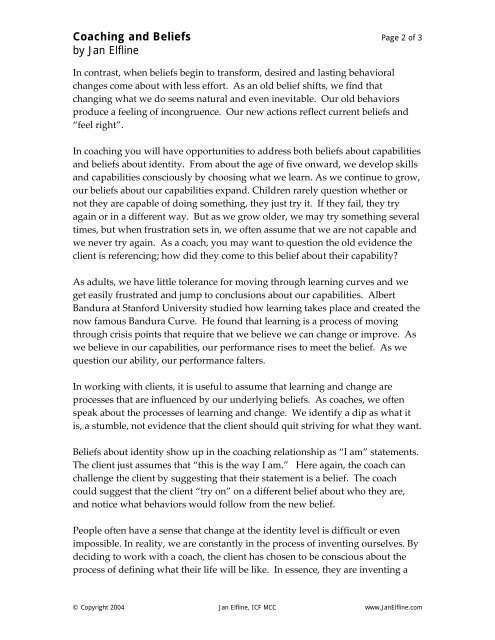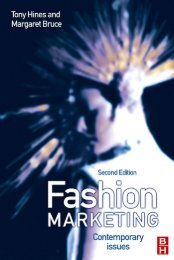Coaching and Beliefs by Jan Elfline
Coaching and Beliefs by Jan Elfline
Coaching and Beliefs by Jan Elfline
Create successful ePaper yourself
Turn your PDF publications into a flip-book with our unique Google optimized e-Paper software.
<strong>Coaching</strong> <strong>and</strong> <strong>Beliefs</strong> Page 2 of 3<br />
<strong>by</strong> <strong>Jan</strong> <strong>Elfline</strong><br />
In contrast, when beliefs begin to transform, desired <strong>and</strong> lasting behavioral<br />
changes come about with less effort. As an old belief shifts, we find that<br />
changing what we do seems natural <strong>and</strong> even inevitable. Our old behaviors<br />
produce a feeling of incongruence. Our new actions reflect current beliefs <strong>and</strong><br />
“feel right”.<br />
In coaching you will have opportunities to address both beliefs about capabilities<br />
<strong>and</strong> beliefs about identity. From about the age of five onward, we develop skills<br />
<strong>and</strong> capabilities consciously <strong>by</strong> choosing what we learn. As we continue to grow,<br />
our beliefs about our capabilities exp<strong>and</strong>. Children rarely question whether or<br />
not they are capable of doing something, they just try it. If they fail, they try<br />
again or in a different way. But as we grow older, we may try something several<br />
times, but when frustration sets in, we often assume that we are not capable <strong>and</strong><br />
we never try again. As a coach, you may want to question the old evidence the<br />
client is referencing; how did they come to this belief about their capability?<br />
As adults, we have little tolerance for moving through learning curves <strong>and</strong> we<br />
get easily frustrated <strong>and</strong> jump to conclusions about our capabilities. Albert<br />
B<strong>and</strong>ura at Stanford University studied how learning takes place <strong>and</strong> created the<br />
now famous B<strong>and</strong>ura Curve. He found that learning is a process of moving<br />
through crisis points that require that we believe we can change or improve. As<br />
we believe in our capabilities, our performance rises to meet the belief. As we<br />
question our ability, our performance falters.<br />
In working with clients, it is useful to assume that learning <strong>and</strong> change are<br />
processes that are influenced <strong>by</strong> our underlying beliefs. As coaches, we often<br />
speak about the processes of learning <strong>and</strong> change. We identify a dip as what it<br />
is, a stumble, not evidence that the client should quit striving for what they want.<br />
<strong>Beliefs</strong> about identity show up in the coaching relationship as “I am” statements.<br />
The client just assumes that “this is the way I am.” Here again, the coach can<br />
challenge the client <strong>by</strong> suggesting that their statement is a belief. The coach<br />
could suggest that the client “try on” on a different belief about who they are,<br />
<strong>and</strong> notice what behaviors would follow from the new belief.<br />
People often have a sense that change at the identity level is difficult or even<br />
impossible. In reality, we are constantly in the process of inventing ourselves. By<br />
deciding to work with a coach, the client has chosen to be conscious about the<br />
process of defining what their life will be like. In essence, they are inventing a<br />
© Copyright 2004 <strong>Jan</strong> <strong>Elfline</strong>, ICF MCC www.<strong>Jan</strong><strong>Elfline</strong>.com
















